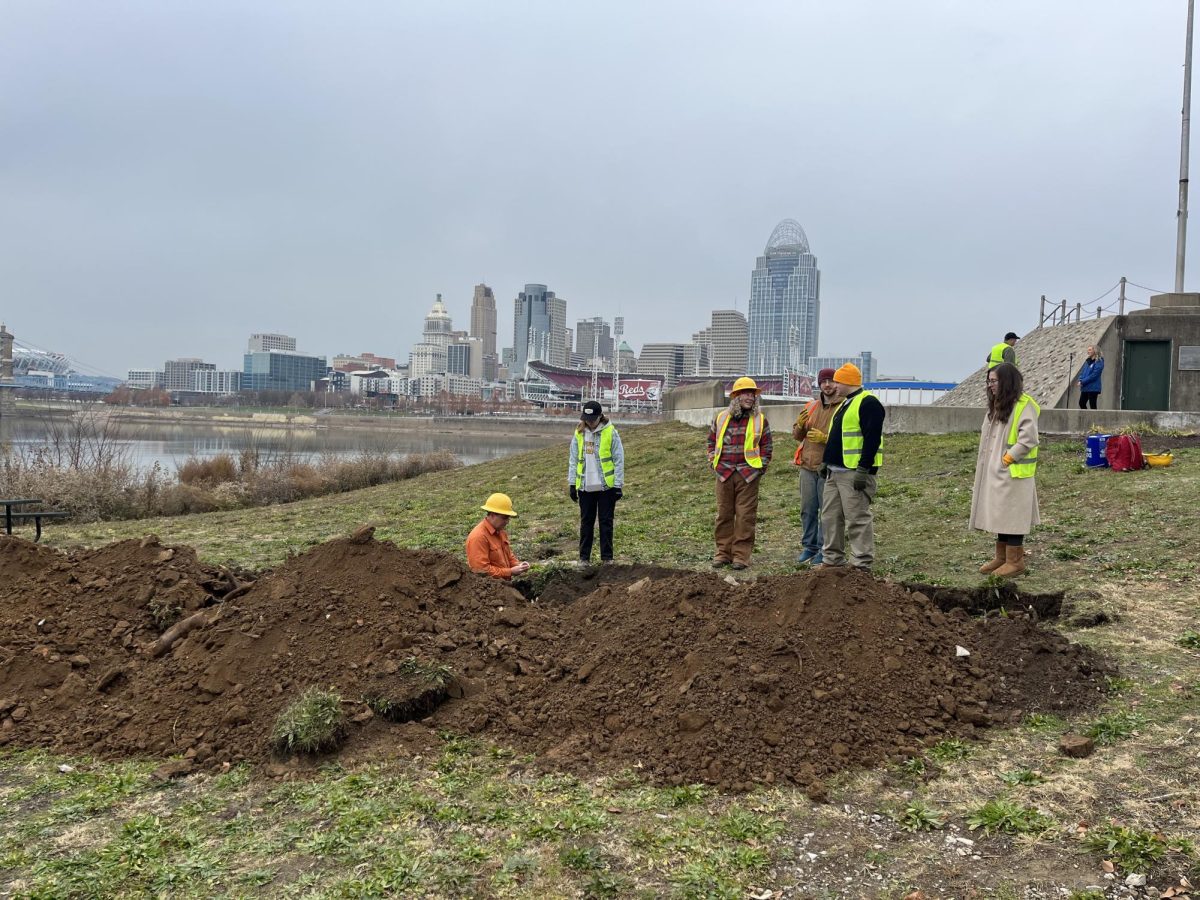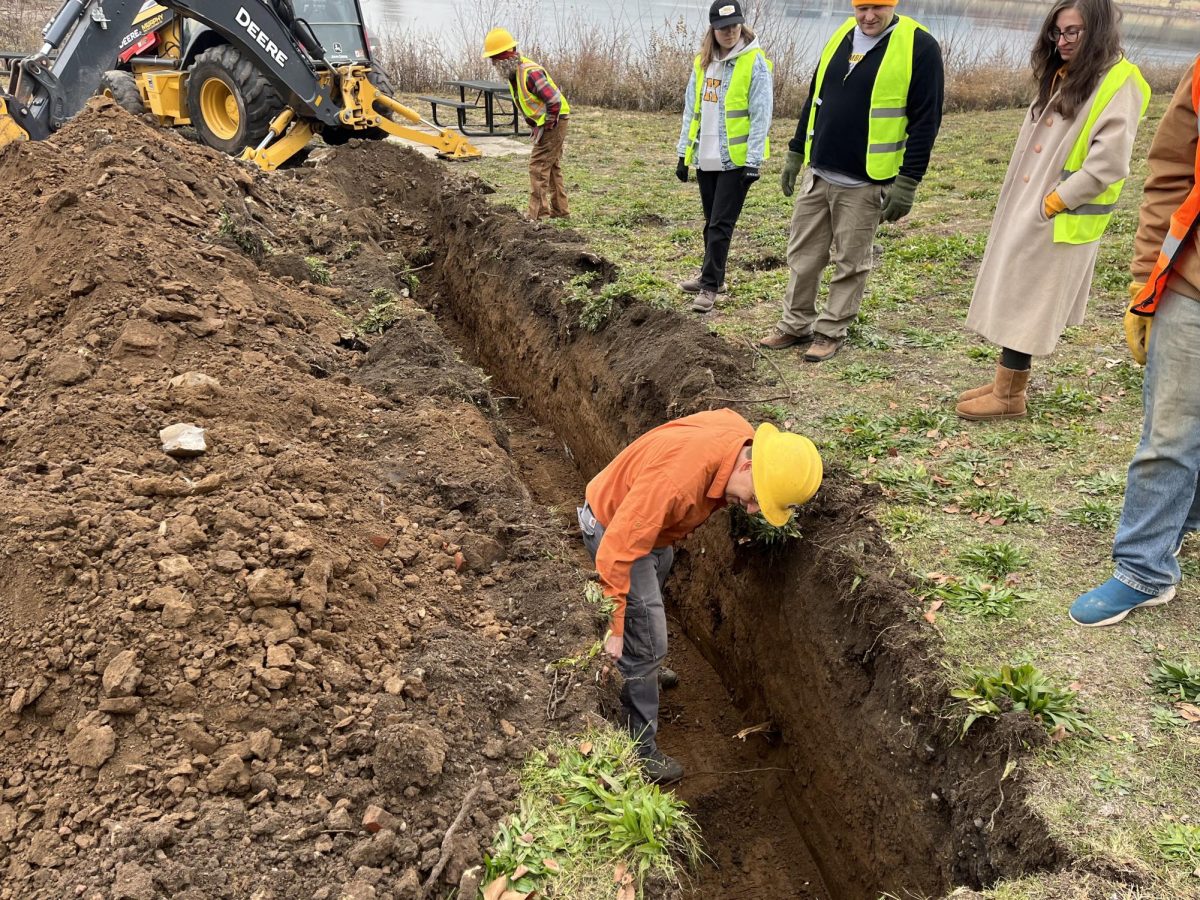
Years of research by Northern Kentucky University’s Master’s of Public History program are coalescing into an archeological effort to dig up artifacts at General James Taylor Park where the Newport Barracks once rested. Stakeholders predict these objects could deepen the rich understanding of the fort’s past gathered from the research.
The Newport Barracks is a historical military base that operated from 1803 to 1894 where the Licking and Ohio rivers meet across from downtown Cincinnati.
Dr. Brian Hackett, program director for the Master’s of Public History, and his students have led the charge by constructing a narrative of what occurred at the Newport Barracks in its nearly century-long occupancy, which places the hands-on side of the project into a historical context that can be shared with the community. The city of Newport partnered with NKU to learn more about what the city’s Historic Preservation Officer Scott Clark deemed “the most historic spot in the entire city.”
Ground penetrating radar, a technology that pelts the ground with radio waves and measures the time it takes for them to bounce back to the surface to identify underground abnormalities, was used earlier this year to map out intriguing excavation sites. Excavation of the first of nine test dig sites began on Dec. 4 at General James Taylor Park. Additional excavation will be carried out if something noteworthy is discovered during the test digs, like a building foundation, said Clark.
The strip of land along the Ohio River is set to be dotted with the excavation sites, a process that is led by the Kentucky Archeological Survey, the state’s chief authority on archaeological projects and cultural resource preservation. Discovered artifacts will be processed and studied by the Public History program and eventually sent to the Behringer-Crawford Museum to be stored and displayed to the public, said Hackett.
At the initial dig, a backhoe bore heaps of dirt that were dumped next to the hole. Professional archeologists climbed down to pick out small artifacts – mostly pottery shards during the first dig – using trowels and brushes to neatly smooth out the exposed earth. While the project is focused on the military history that took place at the site, what’s suspected to be artifacts from the Native American culture of Fort Ancient were unearthed as well, said Hackett.
The Newport Barracks site, though one of the most historically vibrant sites in the area, is also a prime hub for research because of the absence of modern developments that bar archaeological pursuits, explained Jason French, curator of collections at the Behringer-Crawford Museum and a graduate of the Master’s of Public History program at NKU. Debate over the history of Fort Washington, the region’s military base in Cincinnati that preceded the Newport Barracks, was sparked in 1952 when construction workers stumbled upon logs that turned out to be remnants of the base’s gunpowder storage house. The workers were building a parking garage for Western & Southern Life Insurance Co.
Having vacant space to excavate along with plentiful primary sources to illuminate the topic boosts the chance of building a definitive understanding of the history, said Preston. “There’s so many places we’ll never dig in… you just don’t have those opportunities.”
General James Taylor Park’s namesake is the founder of Newport. Taylor lobbied to build a military post in Newport, donated the land and oversaw its development, explained Hackett.
The Newport Barracks was a stronghold for several significant moments in American history. As a staging area and training base, it played a key role in furnishing and deploying soldiers during the War of 1812. It was the starting point for soldiers who traveled to the Battle of the Thames in Ontario, Canada, where the storied Shawnee chief Tecumseh was killed. During the Mexican-American War, the base served as a recruiting depot where hundreds of soldiers were processed. It continued its recruitment function and held war prisoners during the Civil War.
“I think the community, and nationally, we’re not as aware of how important this site was during the 19th century and during early conflicts,” said Preston.
Flooding imperiled the station in the late years of its operation, eventually reducing it to a state of disrepair, leading to its closure in 1894, according to WCPO.
The vast history that stomped upon the grounds of the Newport Barracks was gradually unveiled with novel detail during the research phase of the project, and now the team gets to see what pieces of the past outlasted the site’s heyday.
General James Taylor Park is due for a makeover following the excavation and the interpretation of its findings. Hackett described placing kiosk exhibits with photographs and descriptions of the base’s past around the park to disseminate what was learned over the course of the project to the general public. Clark expects to honor the land’s history while maintaining its modern use as a park with the modifications in store for it.
“We’re hoping to have a better understanding of the barracks. How it was set up, the contributions it made not only to Newport history but to American history,” said Clark. “The idea is to really be able to interpret this space so that it’s an enhancement to a park.”


